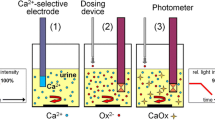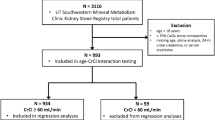Abstract
Nephrolithiasis is thought to be governed by urinary thermodynamic and kinetic risk factors. However, identification of one or more of these factors which consistently and unambiguously differentiates between healthy subjects (N) and calcium oxalate (CaOx) renal stone patients (SF) remains elusive. The present study addresses this challenge. 24 h urines were collected from 15 N and 10 SF. Urine compositions were used to compute thermodynamic risk indices including urinary ratios, quotients and supersaturation (SS) values, while CaOx metastable limits (MSL) were determined experimentally. Crystallisation kinetics was determined by measuring rates of particle formation (number, volume, size) using a Coulter counter multisizer (CC) and a Coulter flow cytometer (FC). Particle shapes were qualitatively differentiated by FC and were viewed directly by scanning electron microscopy. Several urinary composition ratios and risk quotients were significantly different between the groups. However, there were no significant differences between CaOx MSL or SS values. Using transformed FC data, the rate of CaOx crystallisation in SF was significantly greater than in N. This was not supported by CC measurements. There were no significant differences between the groups with respect to particle size or CaOx crystal growth rates. Single and aggregated CaOx dihydrate crystals were observed in both groups with equal frequency and there were no differences in the kinetic properties of these deposits. A few CaOx monohydrate crystals were observed in SF. Although several risk factors were found to be significantly different between the groups, none of them were consistently robust when compared to other cognate factors. Arguments were readily invoked which demonstrated inter-factor inconsistencies and conflicts. We suspect that a unique discriminatory factor, such as any of those which we investigated in the present study, may not exist.




Similar content being viewed by others
References
Robertson WG, Peacock M (1983) Review of risk factors in calcium oxalate urolithiasis. World J Urol 1:114–118
Tiselius HG (1997) Risk formulas in calcium oxalate urolithiasis. World J Urol 15:176–185
Laube N, Kleinen L (2011) Risk indices. In: Rao PN, Preminger GM, Kavanagh JP (eds) Urinary tract stone disease. Springer-Verlag Limited, London, pp 355–368
Hess B, Kok DJ (1996) Nucleation, growth, and aggregation of stone-forming crystals. In: Coe FL, Favus MJ, Pak CYC, Parks JH, Preminger GM (eds) Kidney stones: medical and surgical management. Lippincott-Raven Publishers, Philadelphia, pp 3–32
Chiriboga J (1963) Some properties of an oxalic oxidase purified from barley seedlings. Biochem Biophys Res Commun 11:277–282
Gruber W, Mollering H (1966) Citrat-lyase und bestimmung von citrate. Biochemische Zeitschrift 346:85–88
May PM, Murray K (1991) JESS, a joint expert speciation system—1. Talanta 38:1409–1417
Ryall RL, Hibberd CM, Marshall VR (1985) A method for measuring inhibitory activity in whole urine. Urol Res 3:285–289
Markovic M, Komunjer L (1979) A new method to follow crystal growth by coulter counter. J Cryst Growth 46:701–705
Rodgers A, Hibbert B, Probyn T (1995) Determination of urinary calcium oxalate crystallisation mechanisms and kinetics using flow cytometry. Urol Int 55(2):93–100
Bewick V, Cheek L, Ball J (2005) Statistics review 14: logistic regression. Crit Care 9(1):112–118
Tiselius HG (1982) An improved method for the routine biochemical evaluation of patients with recurrent calcium oxalate stone disease. Clin Chim Acta 122(3):409–418
Tiselius HG (1983) Different estimates of the risk of calcium oxalate crystallization in urine. Eur Urol 9:231–234
Tiselius HG (1984) A simplified estimate of ion-activity product of calcium phosphate in urine. Eur Urol 10:191–195
Parks JH, Coe FL (1986) A urinary calcium-citrate index for the evaluation of nephrolithiasis. Kidney Int 30:85–90
Tiselius HG (1989) Standardized estimate of the ion activity product of calcium oxalate in urine from renal stone formers. Eur Urol 16:48–50
Tiselius HG (1991) Aspects on estimation of the risk of calcium oxalate crystallization in urine. Urol Int 47:255–259
Esen T, Akinci M, Tellaloglu S (1994) Stone formation risk index (SFRI): a possible prognostic factor governing the need for metaphylaxy. In: Ryall RL, Bais R, Marshall VR, Rofe AM, Smith LH, Walker VR (eds) Urolithiasis 2 Proceedings 7th International Symposium on Urolithiasis. New York: Plenum Press, pp 410
Daudon M, Labrunie M, Ivaldi A, et al (1996) A new crystallization risk index (CRI) for calcium oxalate (CaOx) stone formers. In: Pak CYC, Resnick MI, Preminger GM (eds) Urolithiasis 1996: Proceedings of the 8th International Symposium on Urolithiasis. Dallas: Millet the Printer Inc, pp 357–358
Porile JL, Asplin JR, Parks JH et al (1996) Normal calcium oxalate crystal growth inhibition in severe calcium oxalate nephrolithiasis. J Am Soc Nephrol 7(4):602–607
McConnell N, Campbell S, Gillanders I et al (2002) Risk factors for developing renal stones in inflammatory bowel disease. BJU Int 89(9):835–841
Robertson WG, Hughes H (1993) Importance of mild hyperoxaluria in the pathogeness of urolithiasis—new evidence from studies in the Arabian peninsula. Scanning Micros 7:391–401
Rodgers AL (2014) Urinary saturation: casual or causal risk factor in urolithiasis? BJU Int 114(1):104–110
Cirillo M, Laurenzi M, Panarelli W, Stamler J (1994) Urinary sodium to potassium ratio and urinary stone disease. The Gubbio Population Study Research Group. Kidney Int 46(4):1133–1139
Tiselius HG (2011) A hypothesis of calcium stone formation: an interpretation of stone research during the past decades. Urol Res 39:231–243
Kok DJ, Khan SR (1994) Calcium oxalate nephrolithiasis, a free or fixed particle disease. Kidney Int 46:847–854
Kavanagh JP (1992) Methods for the study of calcium oxalate crystallization and their application to urolithiasis research. Scanning Micros 6:685–705
Ryall RL, Chauvet MC, Grover PK (2001) A space oddity. In: Kok DJ, Romijn HC, Verhagen P, Verkoelen CF (eds) Eurolithiasis 9th European Symposium on Urolithiasis. Shaker Publishing, Maastricht, pp 273–274
Wesson J, Worcester E, Weissner J et al (1998) Control of calcium oxalate crystal structure and cell adherence by urinary macromolecules. Kidney Int 33:952–957
Ryall RL (2011) The possible roles of inhibitors, promoters and macromolecules in the formation of calcium kidney stones. In: Preminger GM, Kavanagh JP (eds) Rao NP. Urinary Tract Stone Disease, London, pp 31–60
Daudon M, Bazin D, Letavernier E (2015) Randall’s plaque as the origin of calcium oxalate kidney stones. Urolithiasis 43(suppl 1):S5–S11
Acknowledgments
The authors wish to thank the South African National Research Foundation, the South African Medical Research Council and the University of Cape Town for financial support.
Conflict of interest
The authors declare that there are no conflicts of interest.
Author information
Authors and Affiliations
Corresponding author
Rights and permissions
About this article
Cite this article
Rodgers, A.L., Webber, D. & Hibberd, B. Experimental determination of multiple thermodynamic and kinetic risk factors for nephrolithiasis in the urine of healthy controls and calcium oxalate stone formers: does a universal discriminator exist?. Urolithiasis 43, 479–487 (2015). https://doi.org/10.1007/s00240-015-0802-4
Received:
Accepted:
Published:
Issue Date:
DOI: https://doi.org/10.1007/s00240-015-0802-4




